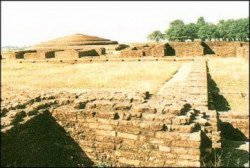Kapilavatthu
Kapilavatthu was the main town of the Sakyān clan and the place where Siddhattha Gotama spent most of his life prior to renouncing the world to become a wandering ascetic. Years later, the Buddha said he had three palaces there – one for the summer, one for the rainy season, and one for the winter, each with a pool of water lilies and lotuses of different colours (A.III,38). The town was described as being ‘rich, prosperous, full of people, crowded and thickly populated’ (S.V,369). Later legend says Kapilavatthu was a magnificent city, whereas it was more likely to have been a small town built around the ruler’s manor house. After the disappearance of Buddhism in India, Kapilavatthu was overgrown by jungle and only identified with certainty in 1973. Archaeological excavations revealed a stūpa first built shortly after the Buddha’s passing away and remains from later times. One often reads that Prince Siddhattha was ‘born and brought up in the foothills of the Himalayas’ but this is not correct. The scriptures say the city was ‘flanked by the Himalayas,’ not in their foothills (Sn.422). The terrain around Kapilavatthu and nearby Lumbinī where Siddhattha was born, is completely flat. The Himalayan foothills only begin about another 20 kilometres further north.
Discovery of Kapilavatthu, K.M.Srivastava,1986.
